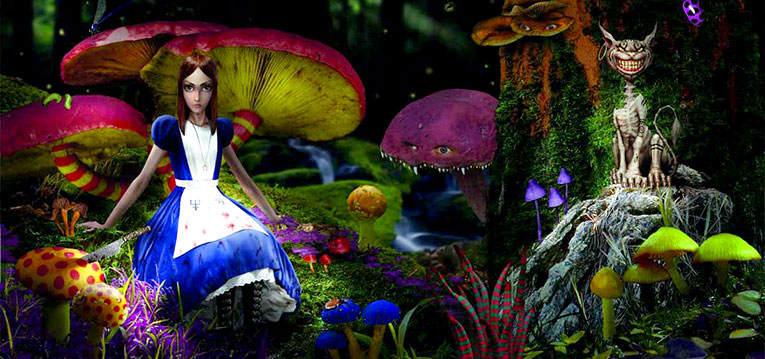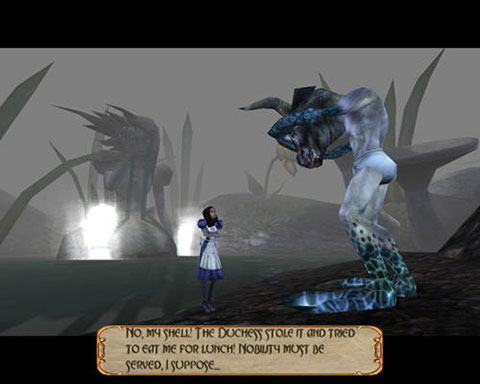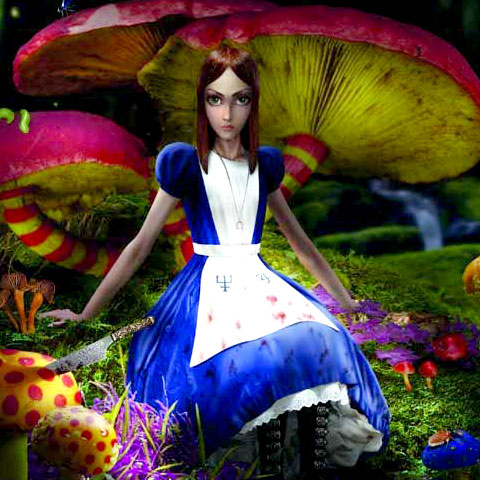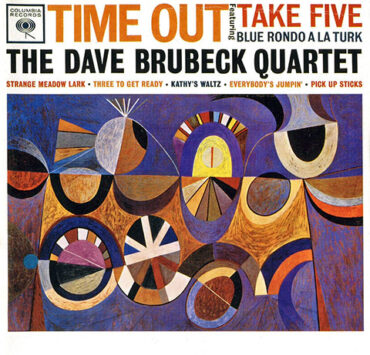She moves across swiftly with a dagger in her hand and an intent that’s difficult to decipher amidst her rage. Her blue and white dress is splattered with blood, as she searches for peace in the ruins of a devastated land.
She is Alice, Lewis Carroll’s admirable creation, in the world of American McGee’s Alice—a world that is in stark contrast to that described in Alice’s Adventures in Wonderland and Through the Looking-Glass.

American McGee’s Alice (Electronic Arts)
A video game developed and published by Rogue Entertainment and Electronic Arts, American McGee’s Alice takes places years after Alice’s Through the Looking-Glass adventure. It starts with the death of Alice’s family in a fire accident at their home and her subsequent admission into a mental asylum for the treatment of a mental disorder. In a disparate visual and psychological state, Alice manifests a horror quite distinct from the book’s plot, where she weaves an imaginary world with a patchwork of understated violence on its inherent fabric of insanity.
A construct of her own mind, this Wonderland is more than just the insane place we’ve come to know through Carroll’s writing. With tentacles protruding from all corners of the wall and poisonous substances flowing through tunnels, it is full of the dark and gloomy imagery of a world gone awry. As opposed to the dreamy precinct of the original Wonderland, the one that unfolds in the game is distinctly dark and gory, and breeds slavery and suffering.
As the Cheshire Puss says to Alice, “Meta essence is the life force of Wonderland.” The existence of this world is purely based on Alice’s desire to defeat the Red Queen. Unless you have bought into Tim Burton’s idea of Wonderland, the 1865 version doesn’t actually pitch the Red Queen as a villainous tyrant. It is thus interesting to see how the grasp of the Red Queen’s arrogance in blatantly ordering executions in the first book or introducing Alice to Mutton in Through the Looking-Glass is translated into her image as an oppressor in other forms of popular media.

It is Alice’s cynical attitude that justifies the flow of the narrative.
The events that unfold in the game arise out of Alice’s need to treat herself, much like her younger self’s desire to escape boredom on that warm, sunny afternoon. The game translates her curiosity and queer experiences from the original narrative into a web of psychologically disturbed and violent personalities in equal measure. More than the mayhem created by Alice’s need to kill and, at times, turn into a red monster, it is her cynical attitude that justifies the flow of the narrative.
Alice was never a character I liked from the get-go. One fine day, I realised that I didn’t have a very good opinion of her because the narrator in the book criticises her character a little too often. I still haven’t figured out if the author was voicing the thoughts in Alice’s mind, or simply judging her ways (‘… for the hot day made her feel very sleepy and stupid’). Conversely, the game tends to generate some amount of sympathy and just as much curiosity, if not more than the book, throughout the escapade.
Being a fantasy, the narration in the book provides enough space to encourage personal interpretation by kids. For adults, a reading or re-reading can bring to light some negative—even violent—undertones. So while the book is about a random dream journey of Alice, the game gives us a specific reason to wander through the Wonderland.
Alice’s Adventures in Wonderland was one of the most amazing journeys that I had as a kid. And it wasn’t just the talking animals, impossible things taking concrete shapes, or the poems, which meant so many different things to everyone who read the book at that age. Rather, it was the possibility of unearthing a new plot design with every new reading. American McGee’s Alice explores one such idea, which may have been left unaddressed in the magnitude of playful imagery in the book. It is renditions like this that uncover the multiple possibilities encapsulated in the story, infusing an air of freshness into a tale that is over a hundred years old.








